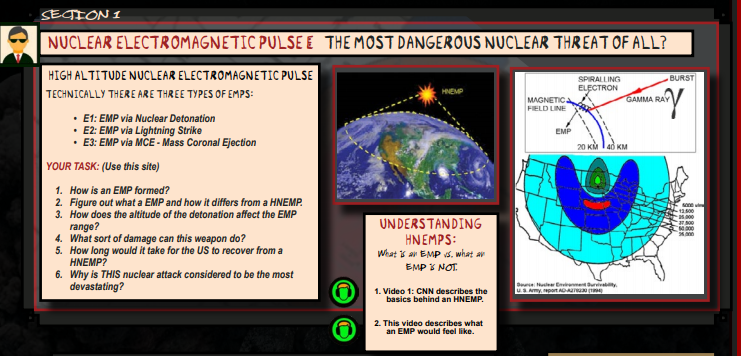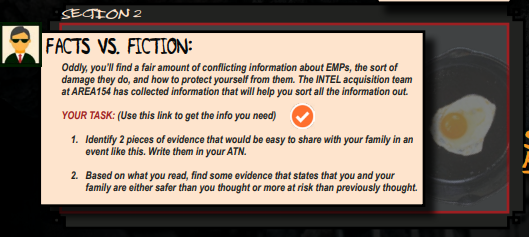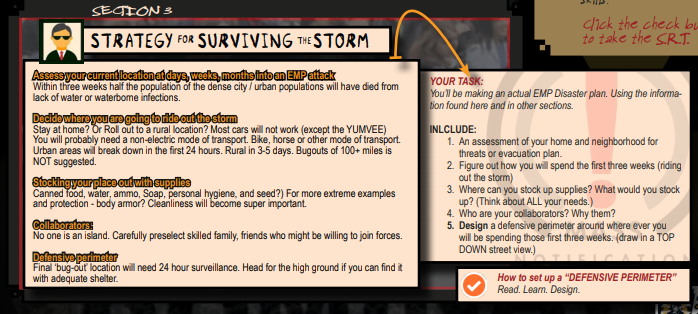Training TWO Guide
Section ONE: (Est. Time =40 min)
High-Altitude Nuclear Electomagnetic Pulse
There is a “Director’s Briefing icon” provides a clear description on what needs to be done in this section regarding EMPs and HOW these forces can play a very debilitating role in a nation-state’s ability to conduct affairs.
The goal here is for the students to field some information data about electromagnetic pulses. Media icon (1) – CNN YouTube video on HNEMPs, Media icon (2) – A clip from the movie “The Fifth Wave” This clip demonstrates (within some degree of realism) the effects of a global high-power EMP on cars and aircraft. It’s dramatic!
The image to the right displays exactly how the electrics-damaging microwaves are produced when the gamma rays are released after a nuclear detonation.
Answers to Section 1 Questions:
- A EMP is formed through a massive discharge of electrical energy or the generation of gamma radiation in Earth’s magnetic field.
— - An EMP is something that produces that microwave pulse, an HNEMP is an EMP that is detonated 60 or so miles into the atmosphere causing the micro wave burst to cover a significantly larger area.
— - The higher the EMP is detonated the greater the range the micro wave burst has to reach devices.
— - EMPs can damage anything that uses electrical circuits. The electrical grid is at risk as well as any data stored on electromagnetic drives.
— - According to the data here, the US is not prepared for repairing the electrical grid failure. It could take years to recover.
— - This attack is possibly the most damaging for a couple of reasons. One, the dependence our society has on electrical devices and the poor condition of our electrical grid. It would only take one device to possibly take out the entire country. (Answers may vary).
Section TWO: (Est. Time = 15 min)
Fact vs. Fiction
There is a “Director’s Briefing icon” there is a lot of “myth” floating around out there. Watch and listen to the brief on how to answer the challenges in this section.
The goal of this section is to separate the facts from the fiction. There are only two things to write here, this section goes pretty fast.
The “Check it out” icon opens the support document and has the information and video media for the students to use.
Answers to Section 2 Questions:
- Pieces of new data to share: (1): The truth of the matter is that we don’t really KNOW how modern devices will react as the last HNEMP test was done in the 1960s off the coast of Hawaii. (2) A classicly powered gear-driven wrist watch would NOT die after an EMP – though an Apple iWatch likely would! Answers for this will vary depending on the information that strikes the student at the time of reading the document.
— - The data here will vary, but as long as the criteria they mention is tied to information in the support document – and they use it – that should be good enough. The idea here is to support the Claim- evidence-reasoning aspect of scientific argumentation.
Section THREE: (Est. Time =40 min)
A Strategy for Surviving the Storm
There is a “Director’s Briefing icon” explains what to do in this section. The focus is on informational application into a cohesive, personalized plan.
The “Check it out” icon takes the student to a support site page that presents ideas and concepts for building a protective defensive perimeter. Believe it or not, there’s quite a bit of multiple sciences at play when considering this build.
Answers to Section 3 Questions:
- Figure out who or what could be a threat based on the student’s perceptions of the place they live.
— - How will they ride out the first three weeks? Do they have the necessary materials to do that? What will they do with their time? Mental and physical health?
— - What and where should the stock piles be placed?
— - Who are the collaborators – who can you depend on, who to avoid?
— - The defensive perimeter should be based on a Google Maps image of their home. Identifying access points and places where people could sneak in to get access to their safe house. Drawing should be labeled and demonstrate concepts from the article.



